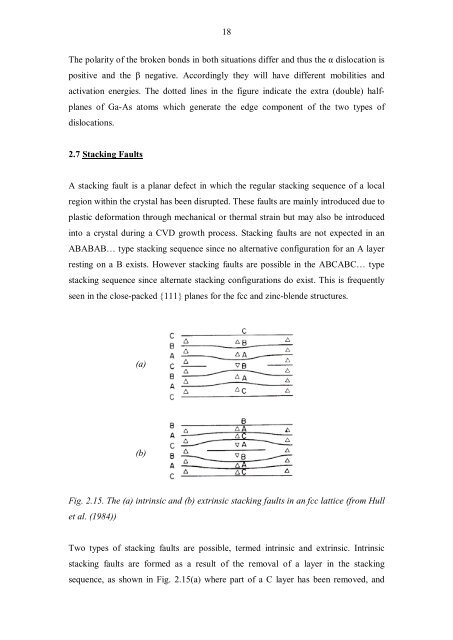Analysis of the extended defects in 3C-SiC.pdf - Nelson Mandela ...
Analysis of the extended defects in 3C-SiC.pdf - Nelson Mandela ...
Analysis of the extended defects in 3C-SiC.pdf - Nelson Mandela ...
You also want an ePaper? Increase the reach of your titles
YUMPU automatically turns print PDFs into web optimized ePapers that Google loves.
18<br />
The polarity <strong>of</strong> <strong>the</strong> broken bonds <strong>in</strong> both situations differ and thus <strong>the</strong> α dislocation is<br />
positive and <strong>the</strong> β negative. Accord<strong>in</strong>gly <strong>the</strong>y will have different mobilities and<br />
activation energies. The dotted l<strong>in</strong>es <strong>in</strong> <strong>the</strong> figure <strong>in</strong>dicate <strong>the</strong> extra (double) half-<br />
planes <strong>of</strong> Ga-As atoms which generate <strong>the</strong> edge component <strong>of</strong> <strong>the</strong> two types <strong>of</strong><br />
dislocations.<br />
2.7 Stack<strong>in</strong>g Faults<br />
A stack<strong>in</strong>g fault is a planar defect <strong>in</strong> which <strong>the</strong> regular stack<strong>in</strong>g sequence <strong>of</strong> a local<br />
region with<strong>in</strong> <strong>the</strong> crystal has been disrupted. These faults are ma<strong>in</strong>ly <strong>in</strong>troduced due to<br />
plastic deformation through mechanical or <strong>the</strong>rmal stra<strong>in</strong> but may also be <strong>in</strong>troduced<br />
<strong>in</strong>to a crystal dur<strong>in</strong>g a CVD growth process. Stack<strong>in</strong>g faults are not expected <strong>in</strong> an<br />
ABABAB… type stack<strong>in</strong>g sequence s<strong>in</strong>ce no alternative configuration for an A layer<br />
rest<strong>in</strong>g on a B exists. However stack<strong>in</strong>g faults are possible <strong>in</strong> <strong>the</strong> ABCABC… type<br />
stack<strong>in</strong>g sequence s<strong>in</strong>ce alternate stack<strong>in</strong>g configurations do exist. This is frequently<br />
seen <strong>in</strong> <strong>the</strong> close-packed {111} planes for <strong>the</strong> fcc and z<strong>in</strong>c-blende structures.<br />
Fig. 2.15. The (a) <strong>in</strong>tr<strong>in</strong>sic and (b) extr<strong>in</strong>sic stack<strong>in</strong>g faults <strong>in</strong> an fcc lattice (from Hull<br />
et al. (1984))<br />
(a)<br />
(b)<br />
Two types <strong>of</strong> stack<strong>in</strong>g faults are possible, termed <strong>in</strong>tr<strong>in</strong>sic and extr<strong>in</strong>sic. Intr<strong>in</strong>sic<br />
stack<strong>in</strong>g faults are formed as a result <strong>of</strong> <strong>the</strong> removal <strong>of</strong> a layer <strong>in</strong> <strong>the</strong> stack<strong>in</strong>g<br />
sequence, as shown <strong>in</strong> Fig. 2.15(a) where part <strong>of</strong> a C layer has been removed, and

















